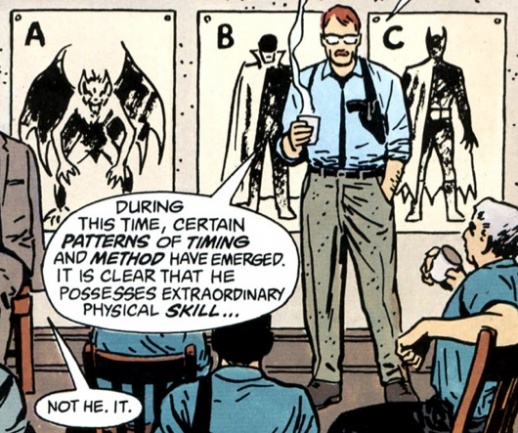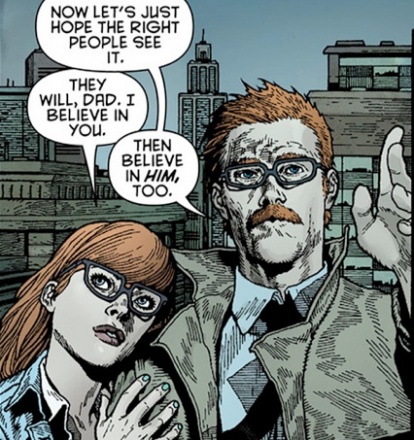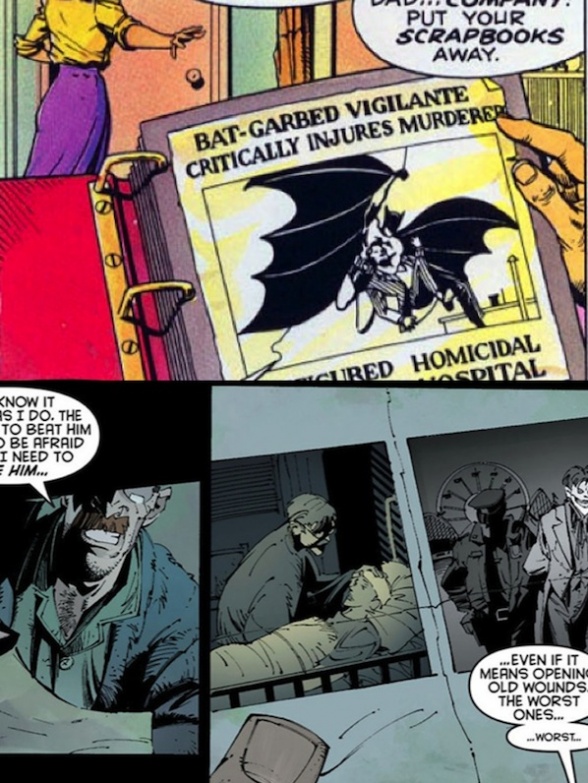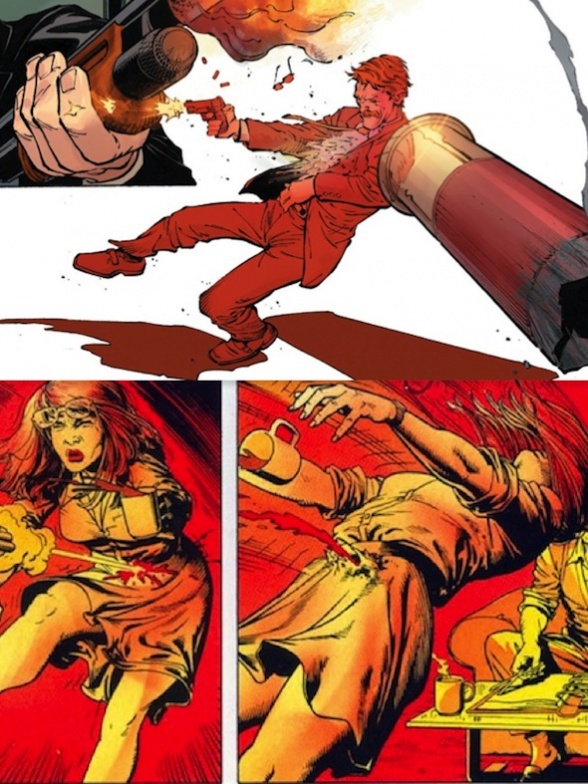
The creative team behind “Batman,” Scott Snyder and Greg Capullo, have taken Jim Gordon on an incredible journey thus far. Since the inception of The New 52, Scott Snyder has been writing Commissioner Jim Gordon as a man who shares a complex history with Batman. That friendship, and that entire way of thinking began the same year everything else did. In “Year One,” Frank Miller and David Mazzuchelli create a chronicle of the seemingly opposite men united by their love for Gotham. As the two of them try to learn to come to terms with the existence of the other, they transition from enemies to friends. What unites them, the desire to make Gotham a better place, to see justice in a world where so little exist, and to give the people of the city hope; is greater than what divides them. By then end of that four issue series the men have established trust, and become allies.
BATMAN’S BEST FRIEND:
The pair have an obvious mutual respect for one another. In first issue of the current run Batman tells the audience, “I like to think a vote for for Batman is a broader affirmation–a vote for all Gotham’s heroes. A vote for the G.C.P.D. Honest, tireless men like Commissioner Jim Gordon.” The respect that Batman feels toward Jim and his men extends beyond the point of admiration; and permeates his identity. He internalizes the mission and effort of the G.C.P.D. as part of himself, as the literal articulation of what he hopes to accomplish in Gotham.
Jim and Batman formed a bond over the course of the Dark Knight’s first year in Gotham. Initially set as opposing forces, the men realized that they shared a goal; protecting the people of Gotham City. In Frank Miller’s “Year One,” Jim and Batman came to an understanding, and formed a lasting friendship.
PLAYING THE PART:
Jim has had a sensibility that winks at the reader for some time. He always knows more than he lets on, but pretends to be in the dark for the sake of keeping up appearances. The faith he has in his friend plays a big part in Jim’s tendency not to question the way in which the Dark Knight does things. A long running tradition, the blind eye for the bat was established way back in Year One.

LEGENDS OF GOTHAM:
Jim knows Gotham’s legends, the folktales, all the things the people of his city fear. When Batman brings up the Court of the Owls, in “Batman” #2, Jim is able to recite the nursery rhyme. He often refers to the misconceptions outsiders have about his city, and the stories that fuel superstition within it. He is faced with scenarios that seem beyond belief, and spends a great deal of time pushing past the darkly romantic facades in an attempt to get to the truth.
Since coming to the city, Jim has continually been confronted with things that seem impossible, the first of which was the Bat Man himself.

BRUCE:
Jim knows Batman’s identity, you can bet your cowl on it. He is simply to aware of all it might mean if he let on. He has always suspected Bruce Wayne may indeed be the man behind the mask.
Little hints about Jim’s knowledge litter the title, he knowingly asks if Batman will be looking after Bruce Wayne, who has refused police guards after being threatened by the Court of the Owls in the second issue.
JUNIOR:
Scott Snyder likes to pick on Jim Gordon. In Detective Comics 871-881, collected as The Black Mirror, Snyder writes Jim’s son, James, Jr. back into Gotham City. The child first acknowledged in Year One has grown up to become a psychopath. What greater pain could their be for a man who has so fully dedicated himself to upholding the law and championing compassion than to realize that his son is incapable of feeling empathy for another human being, and may in fact be a ruthless murderer?
Jameses Junior and Senior both acknowledge that the damage within Jr’s brain may have been caused by the fall. Here’s what they are talking about:
Continued below
That act becomes incredibly important in hind sight. On the surface this is the moment in which Jim and Bruce (or Batman) bond, and resolve to fight crime in Gotham together. Below that, at the very least, Batman saves a kid who grows up to be a really lousy human being. Another more frightening scenario is that because he was so green at that time, Bruce made an preventable error while saving the baby that somehow caused him to grow up to be a monster. Whatever the details, this moment is of key importance when trying to understand the relationship between Bruce and Jim.
HOPE:
The hope that Jim has in Batman is almost religious in its fervor. It goes beyond a ‘he’ll get ‘em in the end‘ feeling, and permeates the heart of the character.

In the face of what becomes of his own son, and all the terrible things that he has seen over the years, the symbol of a hope that can supersede all that seems evident about human nature becomes an essential for Jim. How can you hope to fight evils that are larger than life if you do not have faith in something equally powerful on the side of good? Jim’s faith is tested when the Joker returns to Gotham City.
TO ERR IS HUMAN:
When the Clown Prince of Crime arrives in the city, paying Gordon a visit is is his first order of business. Smoking cigarettes has long been a vice of Gordon’s. He has been trying to quit for as long as anyone can remember. The Joker shames him for his weakness, his humanity, his flaws; he reminds JIm that he is not perfect, that he falls short of the ideal good. First he does so in a subtle way, reminding Jim that he been keeping things from his daughter whom he loves so much, and then in a more overt hateful way reminding him that he failed that daughter.

The Joker has long been after Gordon, out to prove that his humanity makes him weak; and that that weakness makes him corruptible. In “The Killing Joke” by Alan Moore and Brian Boland, this idea is tested, it would seem to the limit, as Jim’s humanity is put on display for all the world to see. The Joker proclaims, “Ladies and Gentlemen! You’ve read about it in the newspapers! Now shudder as you observe with your very eyes, that most rare and tragic of nature’s mistakes! I give you … the average man!”
Jim is resolute in his commitment to show the Joker that he cannot intimidate him. The Joker feeds on chaos and fear. By maintaining the guise of composure, Jim attempts to prove that he can withstand whatever the villain may have in store for him. Jim has always had something to prove when it comes to the Joker. Failure is often tantamount to humanity. The Joker continually tries to illustrate that the more positive aspects of human nature, like compassion and care are associated with pain; while the darker aspects of that nature give you power and control. By being able to divorce yourself from the people and ideas you love you can stamp out the weakness associated with caring, according to the villain. Even after being tortured, and watching his daughter suffer in unthinkable ways, Jim maintains his will to fight evil with good. Even after all the Joker has done to him in The Killing Joke, when Batman swoops in to save the day Jim tells him, “I want this done by the book, by the book you hear? We have to show him! We have to show him that our way works!”
LOST IN MY MIND:
Jim is then singled out by the Joker, attacked in a passive way that is marked by a keen understanding of his behavior and an intimate knowledge of his home. Early in issue #13 Gordon points out to a colleague that Jackson’s face on a twenty is looking left when it should be looking right, thus the bill is counterfeit, echoing the earlier conversation in which Detective Harvey Bullock tells Gordon they, ‘should have seen it coming.’ Batman suspects that the Joker will come after Jim, he goes to warn him. He finds him sitting on the corner of an empty bed, with the weight of the world on his shoulders.
Continued below
This mirrors the first moment that Jim contemplated what Batman could actually mean to Gotham City in Year One. In this scene Jim’s bed was not empty, but occupied by his wife, the mother of his children. He still had hope that they might grow up to lead happy lives. As he now sits alone he must be thinking of how much has changed, how bitterly disappointing the world can be, and how much this menacing city has taken from him. He has lost so much, his wife left him, his son grew up to become a villain, and his daughter’s life was shattered.
WORTH A THOUSAND:
At the moment of his attack, Jim reaches for photos in his nightstand that depict the events of “The Killing Joke.” As he looks back he is unable to look forward; this is the moment the Joker has planned for. The photos are laced with a heparin-based substance that causes him to begin bleeding from his pores after he touches them.

At the moment before Barbara is attacked, Jim was looking at a scrapbook full of old cases. Again, while reliving the past, he fails to anticipate the future. The Joker mocks Jim’s sentimentality in “The Killing Joke.” He tells the commissioner,
Memories can be vile, repulsive little brutes. Like children, I suppose … but can we live without them? Memories are what our reason is based upon. If we can’t face them, we deny reason itself!
Taking this into account, Jim’s connection to the past is tantamount to his commitment to rationality. The current incarnation of Jim is as committed to maintaining his connection to memory as he has ever been.
BUT WHAT IF?:
Snyder is willing to put the events of “The Killing Joke” through a different lens in “Death of the Family.” After the Joker proclaims that he knows the identities of the Bat-family, Barbara questions his motives for attacking her. She asks Bruce, “[What] if he knew … if he knew I was Barbara, then the time he came to my father’s house…” Bruce reassures her that the Joker was after her father, and that attack had nothing to do with Batgirl. In this way Snyder inverts the intention of the brutal events of “The Killing Joke,” turning the motive of the madman on it’s head. Perhaps this latest attack on Jim was part of a plan to get to Barbara, and perhaps that attack first attack was, too. But without a doubt all of these events are aimed at getting to Batman.
BEDSIDE MANNER:
The Gordon family’s involvement with Batman has cost them dearly, but it has always been a prices they were willing to pay because of their faith in what he represents. After Barbara’s attack, Batman visits her in the hospital.
While Barbara’s hospital room is populated by doctors, detectives, and the Caped Crusader himself; Jim’s is empty. Batman and Nightwing discuss the situation on a ledge outside his window. This marks Jim as an outsider. Upon waking up, Barbara calls out to Bruce, not Batman; this is something Jim would never do. He will not cross that line, and thus remains on the fringe of the family; the only hero not wearing a mask.

THE OUTSIDER:
The Joker echoes the idea that Jim is not a true member of the family, and again states that his love for his family and the city of Gotham make him weak. While confronting Batman during his epic return to Gotham, the Joker says:
Your friend, Gordon. He seems strong, but deep down, no, no, no. He’s a bleeder. You see? He bleeds for everyone, the city, his men, his daughter … a tender bleeder. Phony.
THE JOKE’S ON JIM:
That’s Jim’s journey in The New 52 thus far, and that’s how we find him here in “Batman” #19. Jim reports to the scene of a robbery in progress, where he is informed that the suspect is, without a shadow of a doubt, Bruce Wayne. The news that his billionaire friend’s son, Damian, has died has undoubtably reached Jim by now. Gordon looks thinner and more haggard than he has in Capullo’s renderings for past issues. He has the look of a man who has been through Hell. He is smoking again,out in public in the light of day; which indicates a certain level of desperation and loss of control. He’s freshly out of the hospital, he’s lived through another encounter with the Joker, and mourned for a child who championed the same things he believes in. We watch as Jim tries to reason with his friend, Bruce, and fails. In “The Killing Joke,” the Joker studied the effects of grief, outrage, and hunger for revenge using Jim Gordon as the Guinea pig. Jim is then kidnapped by the Clown Prince of Crime and made to suffer through torture and humiliation; all in the name of proving Joker’s hypothesis: “All it takes is one bad day to reduce the sanest man alive to lunacy”
Continued belowWe join Jim in “Batman” #19 as he is again faced with the question, can one bad day ruin your life?
HEARD ‘ROUND THE WORLD:
Jim is unaware that the man he is confronting is actually Clayface, to him it must appear that the strain of grief has claimed Bruce’s sanity, proving the Joker correct. At the hand of a friend, Jim finds himself a victim of a mad, random, and pointless act of violence. Visually and thematically the moment hearkens back to the events of The Killing Joke.

Barbara finds herself asking why, grasping for any sense of logic or meaning that could anchor her in this unthinkable situation. The Joker’s answer reinforces the idea that the act is senseless. When Barbara asks the Joker why he is doing this, he tells her, “To prove a point. Here’s to crime.”
Jim too questions the man holding the smoking gun after he is fired on he says, “Just tell me why, Mr. Wayne.” Bruce’s response echoes the hollowness of the Joker’s explanation, “Sometimes being a hero gets old.”
It’s important to note that the Bat-insignia is exposed under Bruce’s shirt. Though Jim withstood The Joker’s test in “The Killing Joke,” it seems to him that the loss of Damian has driven Bruce mad. In this moment, Jim is forced to question everything he believes about human resilience, and the power of the symbol of Batman. It must seem, in Jim’s mind at least, that one bad day has ruined Bruce Wayne, and possibly Batman. This moment shatters so much of what enables Jim to function. He loses the ability to deny that Bruce is Batman, he loses his faith in the idea that people are resilient, and his hope that the way that he and Batman do things works. While we know that the criminal assaulting Jim is not in fact Bruce Wayne, we should consider the situation from his perspective. He has just lost everything he believes in this moment. His mind is the darkest place in Gotham today, as he finds himself the victim of another cruel joke.



